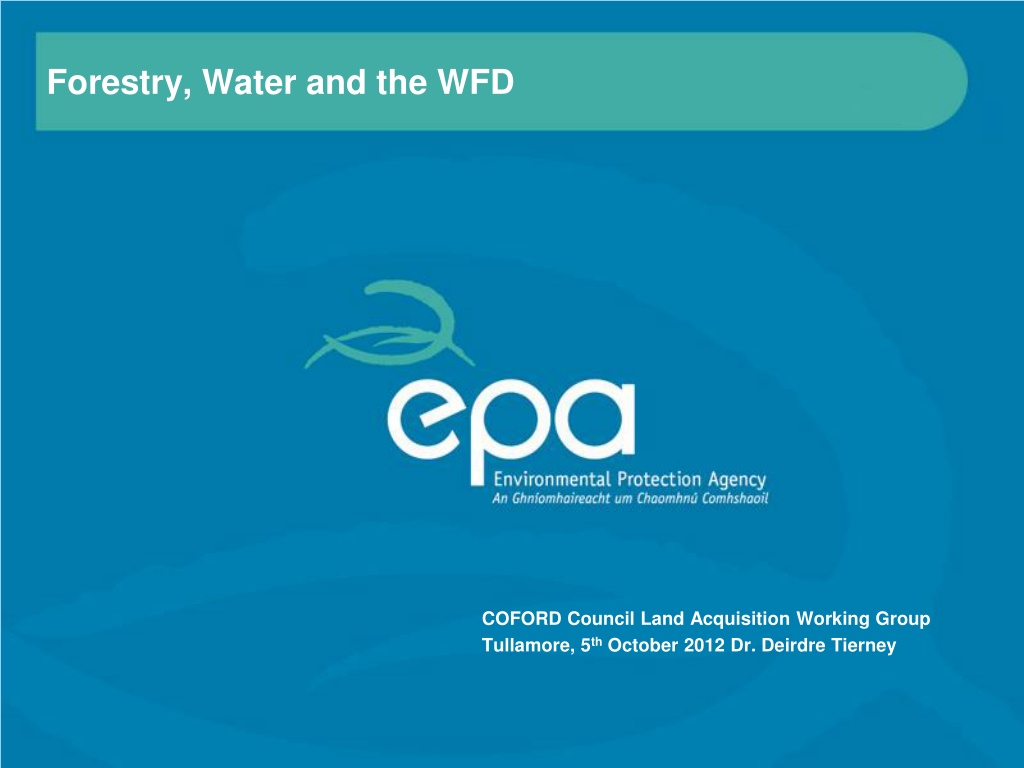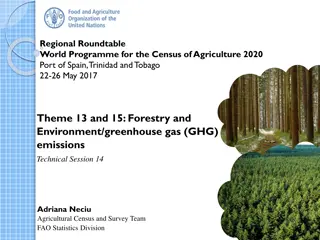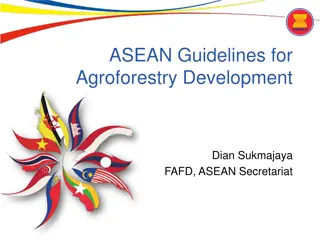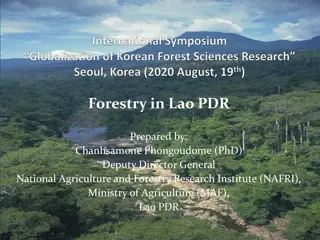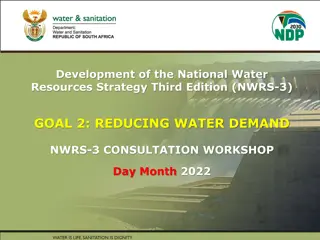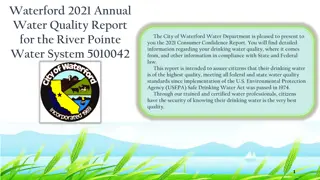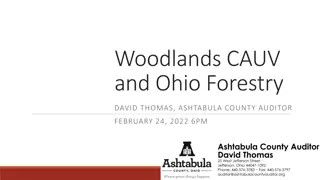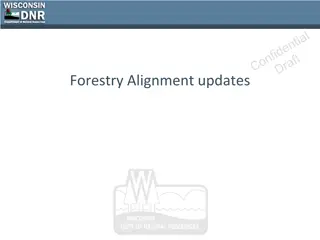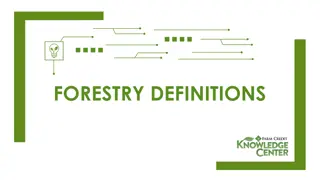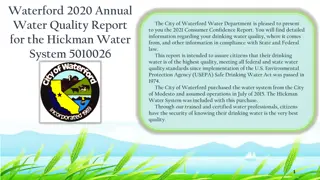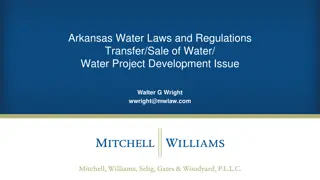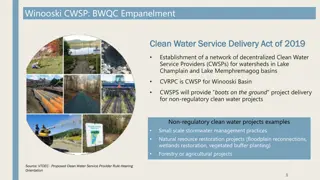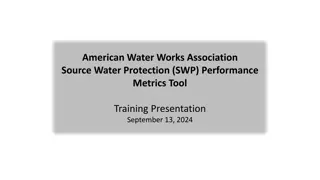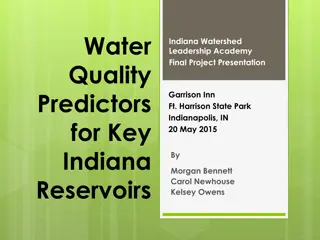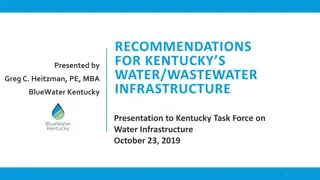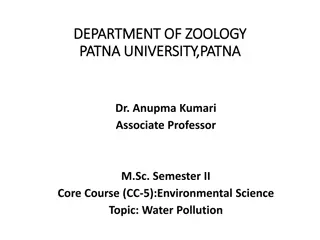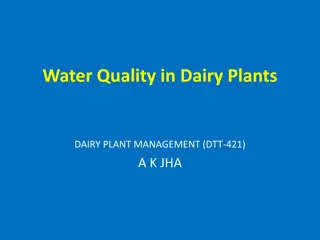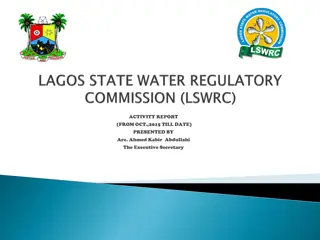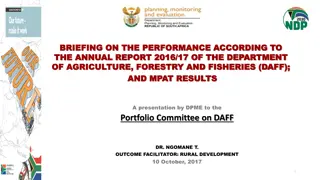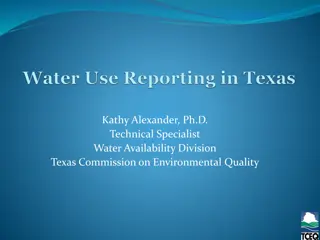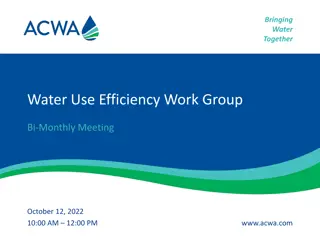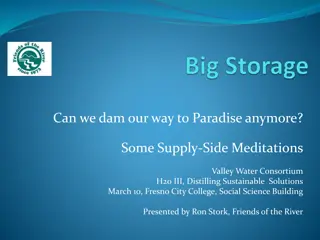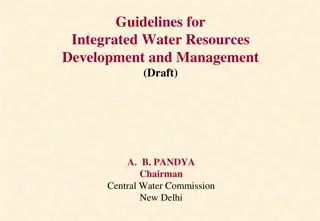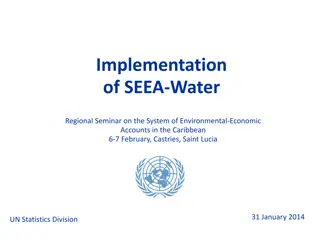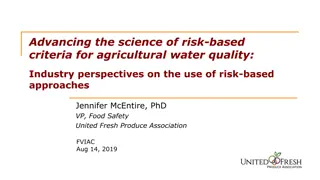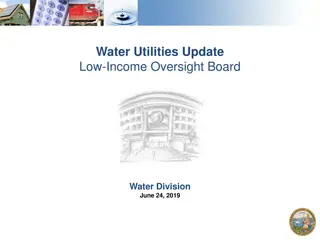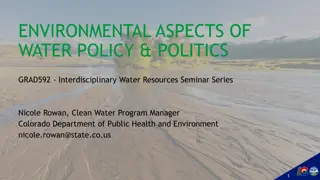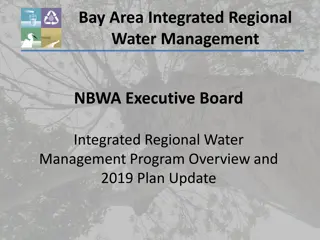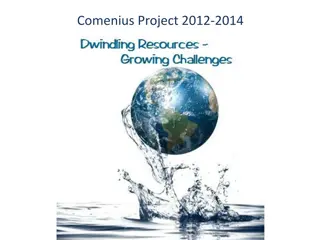Understanding Forestry Impact on Water Quality - Presentation Insights
This presentation delves into the correlation between forestry practices and water quality within the context of the Water Framework Directive (WFD). It highlights the sensitivity of deep peats in uplands to various pressures, emphasizes the need for precautionary measures due to the lack of conclusive research on efficacy, and outlines the objectives and measures outlined by the WFD to achieve and maintain good water status by 2015. The importance of protected areas, monitoring, and mitigation strategies are also discussed.
Download Presentation

Please find below an Image/Link to download the presentation.
The content on the website is provided AS IS for your information and personal use only. It may not be sold, licensed, or shared on other websites without obtaining consent from the author. Download presentation by click this link. If you encounter any issues during the download, it is possible that the publisher has removed the file from their server.
E N D
Presentation Transcript
Forestry, Water and the WFD COFORD Council Land Acquisition Working Group Tullamore, 5thOctober 2012 Dr. Deirdre Tierney
Why this presentation? Forestry in the context of the WFD Emphasise, the most sensitive areas i.e. deep peats in uplands are susceptible to all pressures and are not suitable for planting Over emphasis on acid sensitive areas - not the only pressure Literature reviews done for acidification, eutrophication and sedimentation under WFD preparation No thresholds set despite research carried out therefore: Precautionary principle applies Little research on efficacy of measures to mitigate pressures e.g. buffer zones Do the measures work on a National basis, do we know?
WFD - objectives Integrated framework for all water categories Achieve Good Status by 2015 Maintaining that status where it already exists (in particular High Status) Preventing further deterioration Reduction in emissions of specific pollutants
WFD - Protected Areas Protected Areas particular mention Article 4: (c) f o r p r o t e c t e d a r e a s ..Where more than one of the objectives under paragraph 1 relates to a given body of water, the most stringent shall apply. Article 6 Register of protected areas Article 8 - Monitoring - for protected areas the above programmes shall be supplemented by those specifications contained in Community legislation under which the individual protected areas have been established.
WFD - Protected Areas EMBEDDED, reported separately
WFD strands or how does it work? Classification Ecological Status Monitoring Assigns status that dictates objectives Assess Programme of Measures (POMS) in achieving objectives Characterisation Report 2005, update 2013 Identified pressures Associated risk (risk assessment) of failing to meet objectives RBD plans 2009, update 2015 Outlines the measures actionable to prevent or mitigate a risk are prescribed Published Obligatory reporting at every stage Every stage scrutinised by the Commission
Forest related Pressures Anon 2005 Article 5 Characterisation report Diffuse Source Pollution Pressure Acidification Eutrophication Suspended solids Priority substances Morphological alteration under intensive landuse Shading and light occlusion
Sensitivity Factors ESBI 2008 Particularly applies to peats
Forest related Pressures EPA Submission - Acidification Ruth covered the mechanisms very well Recent studies: No significant changes in pH or aluminium concentrations in 60 acid sensitive lakes (Burton and Aherne, 2012) Mechanism - sea-salt inputs and increases in dissolved organic carbon concentrations - also in Scotland (Dunford et al., 2012) supporting evidence Impact on chemistry and biology found (Kelly-Quinn et al., 2008) in forested streams particularly on peats overlying base poor geologies Coincide with High status waterbodies Climate change PEATS
Forest related Pressures EPA Submission - Eutrophication Nutrient release from coniferous plantations on peat soils occurs: In the early fertilisation phase Following clear-felling brash upcoming problem Mid cycle aerial fertilisation with N or P on poorly performing plantations is also an issue Broadcasting of nutrient granules directly into water or onto adjoining buffer strips
Forest related Pressures EPA Submission - Suspended Solids Drainage activities at establishment New planting and clear-felling - temporal and spatial dimension Impacts on salmonid spawning areas or where freshwater pearl mussel populations
Forest related Pressures EPA Submission - Priority Substances Cypermethrin is used to control pine weevil particularly in newly planted trees Primarily associated with sheep farming but some evidence of loss of invertebrate taxa inside fenced forestry plantations (suspected) Decline in ecological status of some remote rivers
Forest related Pressures EPA Submission - Hydrological effects Mature forest canopy can divert large quantities of water via evapotranspiration -may reduce the flow of water in rivers Impacts of climate change -reduced rainfall in summer the impact on juvenile salmonid populations At the clear-felling stage - flashiness leading to flood damage or erosion and increased silt transport
Loss of High Status Aquatic Ecology Relatively minor disturbance within a catchment can cause the loss of high ecological status - Drainage, fertilisation, land clearance, road building, house construction, septic tanks
Programme of Measures Two literature reviews were commissioned to assist the development of measures by further describing pressure impacts from forestry (Hutton et al., 2008, Johnson et al., 2008) Two research project were commissioned to address gaps identified in the Characterisation Report for forest impacts in acid sensitive areas (Kelly Quinn et al., 2008) and to further describe eutrophication and sedimentation arising from forest activities (Harrison et al., 2008).
Forestry Measures - Acidification Acidification measures: Acidification appears on current evidence to be a management problems with Irish forest on some soil types, notably peat soils and to lesser extent peaty podzols on metamorphic and sedimentary rock. Measures include the following: avoid or limit (to below critical thresholds) afforestation on 1st and 2nd order stream catchments in acid sensitive catchments restructure existing forests to include open space and structural diversity through age classes and species mix, including broadleaves mitigate acid impacts symptomatically using basic material (e.g. limestone or sand liming) Ref:ESBI, 2008
Forestry Measures - Acidification Acidification measures: Implement measures to increase stream production for example with native woodland in riparian zones. Revise the Acidification Protocol to ensure actual minimum alkalinities are detected (i.e. ensure sampling under high flow conditions) and the revision of boundary conditions for afforestation in acid sensitive areas. Some practical some are not.
Forestry Measures - Eutrophication and Sedimentation Eutrophication measures/ Sedimentation measures: Eutrophication and sedimentation pressure are identified primarily with forestry activities, principally clearfell, roading, and, in certain circumstances, aerial fertilisation occurring on peat soils. In some instances the impacts may be confined to the headwaters of streams and can be critical where sensitive catchments are involved with sensitive habitats and species further downstream. Measures to control nutrient and sediment load from forestry operations include; avoid or limit forest cover on peat sites; change the tree species mix (e.g. broadleaves) on replanting limiting felling coup size
Forestry Measures Eutrophication and Sedimentation new forest structures on older plantation sites (including new riparian zones, drainage layouts, species mix, open areas) establishing riparian zone management prior to clearfelling enhance sediment control manage catchment drainage to increase residence times and soil wetting, including no drainage in some locations Consider prohibition of aerial fertilisation on sensitive/ protected sites No replanting on certain hydrogeological settings (peat soils) on sensitive sites. Evaluation of Efficacy?
Forestry Measures Hydromorphological FH Hydromorphological measures: Hydromorphological impacts can occur both from reduced water flow in catchments, due to increased evapotranspiration, in dry weather periods and from enhanced peak flood events increased flow from forested areas with large drainage networks established before the introduction of environmental guidelines. Further research is necessary in this area to quantify the potential impacts. Measures which have been recommended include: auditing of existing drainage networks in forest catchments enhanced drainage network management minimise drainage in peat soils Planning and modelling to cope with reduced and enhanced flows during forest life cycle
Forestry Measures Pesticide use FP- Pesticide use measures: Pesticide use is generally associated with forest establishment (herbicide) and with re-establishment post clearfelling (herbicides and insecticides). Measures which have been recommended include: reduction in pesticide usage pre-dipping of trees in nurseries prior to planting out development of biological control methods maintaining registers of pesticide use (it is acknowledged that this is a national issue relating to pesticide use in general across all sectors)
Measures relating to Forestry It is envisaged that for a given area the most appropriate measures will be adopted from the suite of measures proposed as these will tend to be site specific.
River Basin District Management Plans (RBDMPs) 7 RBDMPs Reported to the Commission 2010 Currently being Evaluated Reporting on POMS progress due 2013 South Western RBD Plan - An example
SWRBD Plan Forestry In the South Western RBD there are 49,930 hectares of private forestry and 68,186 hectares of public forestry. A risk assessment of acidification, eutrophication and sedimentation pressures based on percentage forest cover and underlying geology and soils has identified 13 rivers that are at risk of failing to achieve the required standards due to potential impacts from coniferous forestry. Where mature plantations of coniferous trees have been established on acid-sensitive soils, it can lead to increased acidity and heavy metal concentrations in the run-off waters from such soils. Forestry activities can introduce extra nutrients; in naturally nutrient-poor areas, that can lead to problems such as excessive algal growth. Road-making and stream-crossing can cause erosion and sediment loss on susceptible soils, afforestation and clearfelling of forests may change flow patterns: and pesticides can damage aquatic organisms if applied incorrectly.
SWRBD Plan Water Management Units The programme of measures The key provisions of the programme of measures are summarised in the following sections. The details of measures for the South Western RBD are contained in the Water Management action plans for the district. . 5.2.7 Control of environmental impacts from forestry .. These pressures include: artificial acidification of waters arising from the presence of coniferous afforestation on acid-sensitive soils. . nutrient enrichment and sedimentation impacts arising from forestry operations (mainly fertilisation and high levels of felling activity) in catchments with forest cover of over 50% on peat soils. .
SWRBD Plan - WMUs The WMU action plans are the basis for detailed implementation programmes, which will guide and monitor the progress of implementation between 2009 and 2015. The principal measures identified in WMU action plans to address the key issues in the South Western RBD include: .. compliance with codes of practice and Forest Service Protocol in the forestry sector; implementing Freshwater Pearl Mussel sub-basin plans (available at www.wfdireland.ie)for the following nine areas: Allow, Ownagappul, Bandon/Caha, Munster Blackwater,Currane, Caragh, Licky, Kerry Blackwater and Gearhameen;
SWRBD Plan - WMUs 28 WMUs
SWRBD Plan - WMUs Forest Service Active role
Recommendations for Forest Service as the consent authority Understand - as a consent & licencing body - the requirements of WFD and promote to its stakeholders Engage with RBDs and relevant authorities Take full account of current and potential future impacts on water of activities it licences and consents Explore opportunities for the positive influence of woodlands and water
Other RBDS and WMUs SE Erkina Water Management Unit Action Plan FORESTRY - Measures to address acidification and sedimentation apply to all but two waterbodies within the WMU .
Other RBDS and WMUs SH West Coast Clare Water Management Unit Action Plan ANNAGEERAGH - Currently moderate status (Q3-4). The quality is mainly moderate for macroinvertebrates along the entire course. There is a large amount of the upper catchment under forestry on peat soils. The Sruhaunakit Stream joins the Annageeragh d/s of Doo Lough, quality is moderate for macroinvertebrates also. Doo Lough is a large abstraction source for a public water supply. ANNAGH (CLARE - Currently poor status (Q3) at site 200 (bridge at Drehidenagh) and good status (Q4) at site 900 (Bealaclugga Bridge). The upper reaches of the Annagh are mainly forestry and agricultural pressures. Quality improves in the middle reaches to satisfactory but drops downstream due to localised pressures and/or because it is affected by seawater.
Summary Forests and Forest practice put waterbodies at risk of failing the objectives of the WFD (Sitka spruce plantations) Peats in uplands are particularly susceptible to all pressures and are not suitable for planting Waterbodies are not allowed to deteriorate fines Protected areas embedded in WFD Precautionary principle applies Measures in RBDMPs but efficacy? research Forestry Service have work to do Alternative forestry needs exploration
